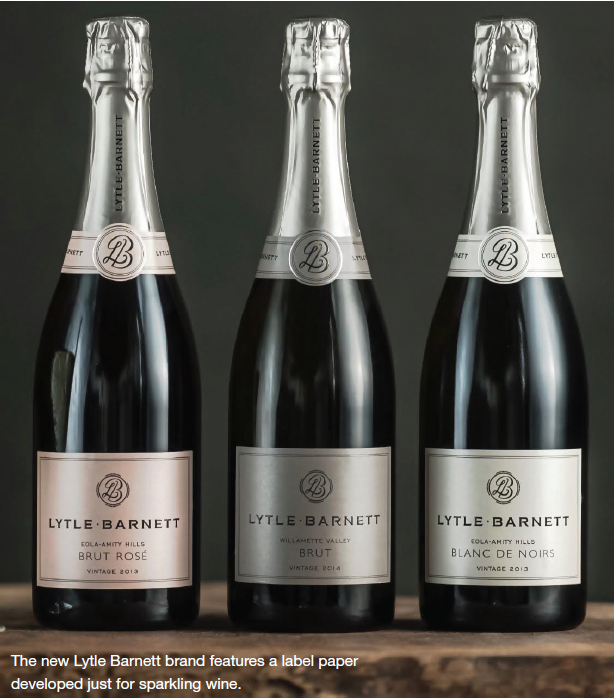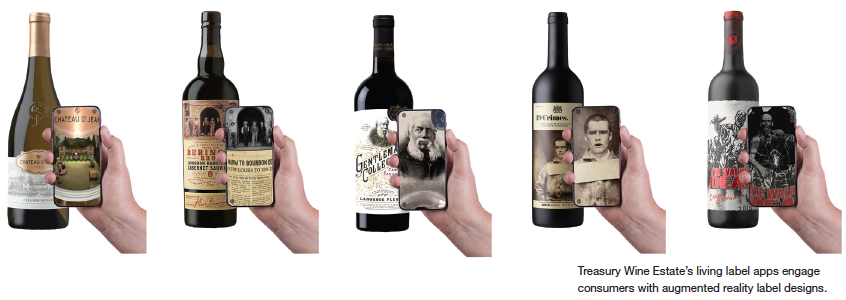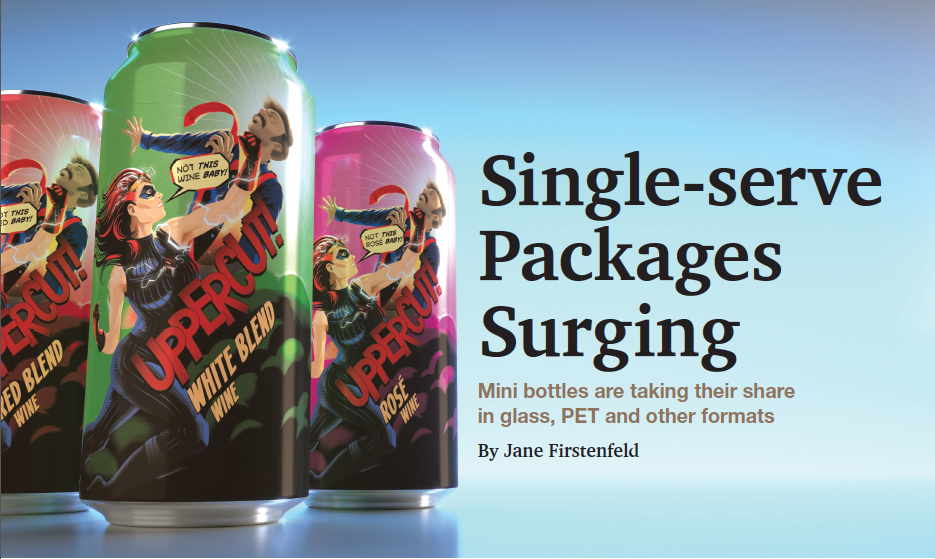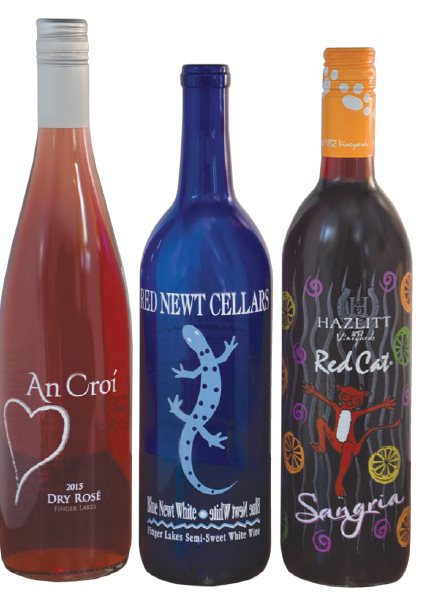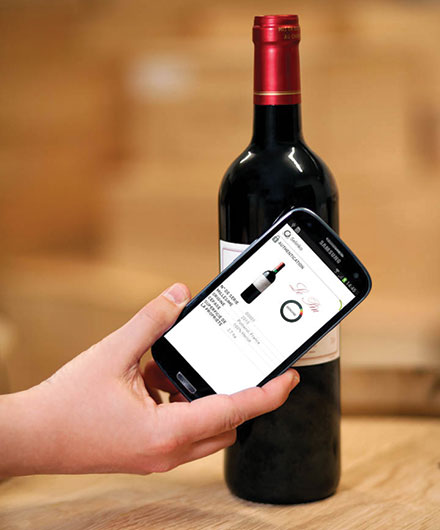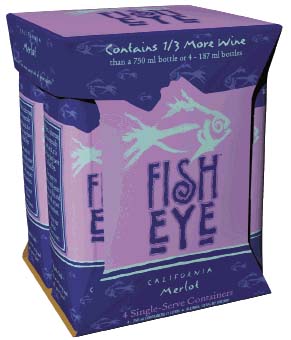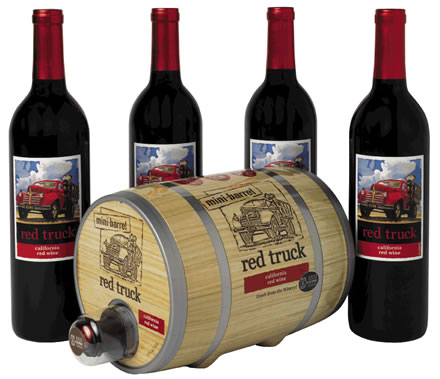
Packaging
by Randall GrahmPackaging
October 2018Give This Person a Cigare: The Doon and Dirty of Wine Packaging
It is a pleasure to discuss wine packaging and labeling, a subject I never imagined I would be qualified totalkabout, but something about which, like it or not, as an entrepreneurial winery owner, I have been compelled to try to master.
READ MORE »
Packaging
October 2018Connecting to Consumers Through Packaging
It was a day packed full of packaging Aug. 9, as some of the leading innovators exhibited their products and services surrounding wine packaging, branding and marketing to nearly 500 wine industry professionals at the Lincoln Theater in Yountville, Calif.
READ MORE »
Packaging
October 2018A Conversation with Jim Cahill of Rutherford Wine Co.
Jim Cahill of Rutherford Wine Co. grew up in a small Wisconsin farming community, but he developed an early interest in wine, taking a cue from his wine-loving father. Cahill’s undergraduate degree is in English from Brown University in Providence, R.I., but he knew that wouldn’t determine his career. He wanted to get into the wine business.
READ MORE »
Packaging
September 2018What's Popping in Sparkling Wine Packaging
According to a 2017 Nielsen study, 71% of consumers don't know what they want when they walk into a store looking to buy some wine.
READ MORE »
Packaging
August 2018Wine Labels for a Sensory Experience
#WIYG (What's in your glass) and how one celebrates #WW (wine Wednesday) or #TT (thirsty Thursday) are the new conversations in wine.
READ MORE »
Packaging
May 2018A Conversation with Lisa Ehrlich Connecting brands and wine packaging, and how to work with a designer
When Chicago native Lisa Ehrlich was growing up in Wisconsin, wine was always on the table. But her interest in wine and food deepened when she spent her junior year in college in Aix-en-Provence, France, where she also picked Grenache grapes during a harvest. Although her studies had prepared her to become a law professor, wine and food turned out to be a bigger attraction, and Ehrlich went on to become a co-founder of Chicago's famed Charlie Trotter's restaurant, where she developed the wine program.
READ MORE »
Packaging
May 2018Big Help for Tiny Wineries
Of more than 10,000 North American wineries currently reported by WinesVinesData, more than 8,000 are categorized as "very small" (fewer than 5,000 cases produced annually). About half of those have what's termed "limited production" (fewer than 1,000 cases).
Many of these tiny wineries produce multiple varieties or brands, and although they may not enjoy the services of distributors under the three-tier system, they still want the benefits of standout packaging for
direct-to-consumer sales: attractive, memorable packages that will bring customers back for more.
READ MORE »
Packaging
March 2018Single-serve Packages Surging
Once opened, 750-ml bottles pose a problem for many wine drinkers, who perceive that quality goes down when wine isn’t consumed within a day or two. Good bag-in-box (BiB) wine offerings are marketed as an alternative. BiB packages are known to preserve wines with their original flavor profiles for longer periods after opening, but brand and varietal choices are still limited. And BiBs, which normally contain 3 or 4 liters, may represent too large a commitment for casual consumers, although they are significantly less costly per unit than similar wines in 750-ml bottles.
This story began as a look into tiny bottles: 375-ml vessels and, almost incidentally, 187 mls. As it turns out, the tinier the better, according to wineries and bottlers we contacted. Hotel mini-fridges and airlines have made 187-ml packages more than familiar to travelers, and alternatives to the tiny bottles abound.
Winery POV
READ MORE »
Packaging
January 2018Going Pro(totype)
Trade shows provide a super source for greeting old friends, meeting new ones and exposure to new vendors and technology. The Wines & Vines Packaging Conference in August introduced us to a novel concept: prototyping for packaging.
READ MORE »
Packaging
November 2017Packaging Suppliers Unveil New Products
Every year, wine industry suppliers of all types submit hundreds of listings touting their newest products and services. Their entries are included in the supplier guide starting on page 40. For readers seeking packaging options, we combed the earliest entries and contacted them with specific questions about their offerings.
Concept and design
READ MORE »
Packaging
October 2017Texture and Metallics Brighten Labels
Just a year ago, wine labels with a dark background were all the rage. They’re still out there, but the newest looks emphasize texturized, metal-accented designs. As in the fashion industry, packaging turns in cycles.
Shopping online and on shelves brought us to recognize this rotation, later confirmed by packaging designers and their clients. Shiny is definitely in. Shimmery papers, precious-metal inks screen-printed onto bottles, transparent inks on silver stock, metallic and holographic foils are all popular, according to Sara Nelson at Sara Nelson Design in Kennewick, Wash. Wineries seem to be craving texture: deep, luscious embosses, textured stock, super-matte varnishes contrasted with high-gloss varnishes and even high-build varnishes, she said.
European wine producers are not usually considered pioneers of modern packaging. However, French emigrée Jean-Charles Boisset, owner of the Boisset Collection that includes Raymond Vineyards, DeLoach Vineyards, Buena Vista Winery and JCB, has demonstrated he has fully adapted to the North American wine industry, introducing some seriously avant garde wine packages.
Raymond Vineyards is a 300,000-case producer in St. Helena, Calif. To mark its 40th anniversary, Boisset and his design team devised a textured “red velvet” label for the 2014 Reserve Selection Cabernet Sauvignon, the very epitome of tactile labels, with a tag line “the dress code is red velvet.” This design won the People’s Choice award in the recent Wines & Vines Packaging Design Awards.
Three wines from the historic, 54,000-case Buena Vista in Sonoma pay tribute to the winery’s founder, Agoston Haraszthy, with metal labels including a star-shaped badge for “Sheriff.”
With his creative team, Boisset himself designs “bejeweled” labels for Buena Vista’s popular “Revenge” red blend. The metal and bedazzled labels are manufactured in coordination with Atlanta’s Margot Townsend. These eye-catching and touch-inducing labels represent a major financial commitment. Megan Long, Boisset Collection communications manager, reports that they cost between $9 and $13 per bottle for front and back labels, depending on quality and quantity. The winery builds its own jigs and molds to provide consistent application. “It’s a difficult process that takes more time to apply than regular labels, so there is added labor cost,” she noted.
Labels for Matua’s 2016 Sauvignon Blanc and rosé vintages have been released to shelves in the United States. Although Matua is a New Zealand producer (normally out of our coverage area) it’s owned by Treasury Wine Estates (TWE), which owns numerous U.S. brands and wineries.
The labels “sense” temperature and change appearance when the wine reaches the ideal serving temperature. Designed by the firm Marks, a member of the design collective sgsco, the labels are printed on Manter Tinteretto Crystal Salt Ultra Wet-Strength stock. Sonoma’s CCL Label does the printing, using a combination of conventional and thermal ink from Chromatic Technologie Inc. in spot areas. Costs for this treatment are minimal, and with standard bottle shapes, there are reportedly no bottling line problems.
According to spokesman Jim Caudill, TWE will most likely extend the thermal “Chill Check” program to other brands. “There are no decisions, just explorations and ideas right now,” he said.
Matua chief winemaker Greg Rowdon said the idea is simple. “It’s all about enhancing freshness and drinkability, making it simple for people to recognize the best temperature to release and enhance flavors without having to consult a confusing table or chart.”
Build in a back-up plan
READ MORE »
Packaging
October 2017Using Innovation in Wine Packaging Design
Nearly 20 years ago, when Corey Beck was still a relatively new winemaker, the namesake behind Francis Ford Coppola Winery wanted a sparkling wine, in a can, with a straw so consumers like his daughter could drink it demurely.
READ MORE »
Packaging
October 2017Avoiding Redesign Pitfalls
Thinking about redesigning your wine brand with a new look or just an updated label? Take care, only about one out of every 10 brand redesigns delivers a significant sales impact, and half of them typically hurt a brand.
READ MORE »
Packaging
August 2017Topping the Bottle: It's a Free-for-All
When searching at trade shows, online and in markets for trends in capsules and closures, we came up…empty. With so many choices, winemakers are free to top off their bottles of wine with whatever style seems the best fit for their customers.
For our annual Closures Issue, some of our winery and supplier sources shared observations about the ever-evolving closure industry. They might inspire you to change your style, or confirm your established appearance.
It all starts with the closure
READ MORE »
Packaging
May 2017A conversation with James Sobbizadeh
When James Sobbizadeh graduated in 1985 from the University of Alabama-Birmingham with a degree in natural science, he took a job with a winery that produced wine coolers in Stockton, Calif. He started in the lab and ended up as the quality-control supervisor. But that job ended, and he moved to a custom co-packer that worked with juices, energy drinks and other beverages. The job wasn’t to the liking of Sobbizadeh, who realized he wanted to continue working with wine.
He found an opportunity to return to the industry in 1989, when he went to work for Fetzer Vineyards in its quality-control department. He became director of production in 1995. Today, from his base in Mendocino County, Sobbizadeh directs a team responsible for bottling millions of cases of wine every year. In addition to Fetzer Vineyards, those wines include brands such as Bonterra, Little Black Dress, Sanctuary and 1000 Stories.
Q:Fetzer is upgrading its bottling lines. What are you changing and why?
READ MORE »
Packaging
May 2017Niche Packaging Services Let You Test the Market
An article titled “Wine Packaging for Leaner Times,” printed in the November 2009 issue of Wines & Vines, stated, “Alternative packaging lies at the confluence of two major trends in the wine industry. The first is economical,” and “environmental awareness has been on the rise.” Many formats such as bag-in-box are much less expensive than the glass + cork + capsule + label paradigm, and they use less energy per case to ship from winery to market, as the packaging is very light. In addition, bags, boxes and cans are easily recycled with a smaller carbon footprint than glass, which requires massive amounts of energy to crush and reheat recycled material to 1,600° F to make a new bottle.
Since that article, convenience has become a third major trend to consider. Millennials love wine but are less interested in traditional packaging. To them, it’s an enhancement if packaging makes wine easier to enjoy, which explains the market success of good wines in heretofore heretical packaging formats such as cans, pouches, single-serve wines packed in their own glasses, under screwcaps, etc. In addition, restaurants are having success with more efficient formats such as recyclable plastic kegs and reusable stainless steel kegs.
You may be considering whether these new packaging formats would work for you. To try it out, you’ll likely want to start with a small test market quantity. But if you don’t have the equipment or training to fill packages like these, where do you begin? Are there vendors for this?
READ MORE »
Packaging
March 2017Bottle Fancy
Wineries of every size labor over their labels (or screen-printed equivalent) to make bottles pop on the shelves and tell their stories in a limited amount of space. Some wineries, though, take a step back and opt for bottles in rare shapes, colors or designs to provide memorable packages.
A singular bottle of an unusual wine inspired our investigation of fancy bottles: Elegancia 2010 Madera Red Wine from 2,000-case Barterra Winery in Half Moon Bay, Calif. This fortified wine made from Tinta Cão, Tinta Madeira and Touriga grapes from California’s Madera appellation has 19.9% alcohol. Barterra produced just 105 cases of this wine, sold exclusively from the winery for $80 per bottle.
The bottle is a true standout, primarily because it stands in two ways: One side of the rounded bottle is flattened, so it can be balanced securely on a counter or tabletop.
The bottle, supplied by Bruni Glass, is not a “shelf item” in North America. It’s a specialty item ordered as needed and shipped from Italy with a minimum quantity required. Winery owner Bart Colucci said he is not aware of anyone else using the bottle in the United States.
“I firmly believe the package is an integral part of the wine experience. Presentation has a great impact on the decision for a customer to purchase the wine. They will not throw the bottle away and will always remember from whence it came. This particular package does just that,” Colucci said. “The exact wine in a jug will taste quite different. Someday, I’ll try this.”
While more standard wine bottles may cost between 25 cents and 80 cents each, depending on quantity and size, this one runs $2.25 plus freight, Colucci noted. The bottling line requires minor modification to accommodate the off-kilter shape. Individually printed and cut oval labels are hand applied, and each one costs $1.36. Bottle tags are individually affixed, and each bottle is hand-dipped in wax. Cartons are special orders, too, and carry only nine bottles each.
These bottles are truly a labor of love for Colucci, who designed the package featuring a portrait of his wife’s grandmother.
Bruni, which was acquired by Berlin Packaging in November 2016, serves the West Coast from its office in Fairfield, Calif. The Italian company sponsors The Bruni Glass Design Award competition, a biennial contest, and puts the winning concepts into its manufacturing portfolio.
Senior sales consultant Marilyn Gapp noted that these specialized bottles usually are employed for higher end wine to make it distinguishable and imply a story to tell. Many clients are small operations like Barterra, but even mega-corporations looking to expand their markets may adopt them, especially to drive interest in their wine clubs.
Clearly these outstanding bottles, which demand higher prices and additional costs for label application and bottling, are aimed at the luxury market. Despite Colucci’s comment that wine in a jug might taste different, at least one established winery has gone back to the jug for one of its premium wines.
Jug-eared
READ MORE »
Packaging
January 2017Tiering Up Wine Brand Portfolios
When the wine industry talks about “tiers,” the word most often refers to the established three-tier system that dominates distribution and sales. But another type of tier is inherent within winery marketing strategies. Even many small-production wineries differentiate among price points, and packaging is the most direct way to do this, whether for hand sales in the tasting room or on retail shelves.
The use of tiering in a wine producer’s portfolio is another version of the “good, better, best” consumer market segmentation strategy. This good, better, best principle acknowledges that customers are not all equal. They have distinctive needs, seek out different product attributes and respond to different price points, according to veteran marketer/brand designer Ed Rice, director of brand strategy at Affinity Creative Group in Mare Island, Calif.
Rice pointed out that this type of differentiation is well known in other categories, especially among automobile brands, which seek to lure different consumer segments with economy through luxury models. (Think Chevrolet-Buick-Cadillac or Scion-Toyota-Lexus.)
READ MORE »
Packaging
November 2016Dress Up Your Packaging
We keep our eyes on packaging products and trends throughout the year. Trade shows such as the Unified Wine & Grape Symposium in January and our own Wines & Vines Packaging Conference in August provide close-up views of the wide world of wine packaging and face-to-face meetings with suppliers from around the world.
For the Winery & Vineyard Supplier Guide published each November, we elicit updates for every category of wine industry suppliers, from vineyard and winery equipment to packaging and marketing services. For this companion feature, we cherry-picked the most intriguing new packaging methods and services and bring you their stories.
Go haute
READ MORE »
Packaging
October 2016How to Create Packaging That Sells
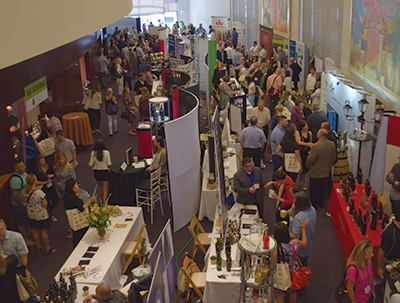
It doesn’t seem to matter how a winery gets there, once it finds the right packaging for a wine brand, better sales will follow.
The right design can come from quirky and offbeat ideas generated in-house and produced with local talent, or it can be the result of a detailed and exhaustive process involving leading design firms. Either way, if a winery can hone in on an effective brand and packaging strategy, its brand will have a definitive advantage on retail shelves.
The trick is finding the strategy.
Experts in design, retail and wine production all discussed how to strike the right balance of brand and packaging at the third annual Wines & Vines Packaging Conference held Aug. 17 at the Lincoln Theater in Yountville, Calif. More than 450 people attended the show, which featured expert seminars, panel discussions, multiple tasting bars, a trade show and on-site brand consultations by several designers.
This year’s conference also included an expanded Wines & Vines Packaging Design Awards that featured winners selected by a panel of expert judges and “people’s choice” awards that were determined by votes of those attending the conference.
One of the day’s most engaging speakers was packaging designer Kevin Shaw, the creative director and founder of design firm Stranger & Stranger. Shaw decried the lack of innovation in wine packaging and provided numerous examples of how spirits, beer and even olive oil do a better job of being innovative.
He said he feared the U.S. wine industry is becoming a more homogenous sector, in which all wine starts to taste the same (to consumers at least) and even look the same. When that happens (as he said it did in the United Kingdom), the next step is steep discounting and an overall decline in quality. “No wonder consumers are bored, confused,” he said.
Shaw went so far as to offer free branding services from Stranger & Stranger for any wine company developing a truly unusual wine concept. “We want to shake the tree, so let’s make something,” he said.
In another conference session, James Stewart, president of Napa Valley’s Stewart Cellars, described how he worked with design firm CF Napa on an overhaul of the company’s second label, Slingshot. Stewart was joined by David Schuemann, owner and creative director for CF Napa, and Steve Lamoureux, senior vice president of product innovation and design for The Nielsen Co., for a panel discussion about the best practices for package design.
Schuemann said wineries should expect designers to provide examples of their work with references as well as the figures that demonstrate a clear return on investment. He said that a request for proposal is then followed by a creative brief, which forms the basis of the entire brand design and package. The brief can then be referred to later in the creative process.
Another popular session featured three wine retailers discussing what wine packaging worked in their stores—and what didn’t.
The speakers included Gary Fisch, owner of Gary’s Wine and Marketplace with four stores in New Jersey, and Debbie Zachareas, the partner and wine director at Ferry Plaza Wine Merchant in San Francisco, Calif., and Oxbow Wine and Cheese Merchant in Napa, Calif. Moderating the panel discussion was Curtis Mann, the wine, beer and spirits buyer for Raley’s Family of Fine Stores, which includes 118 supermarkets.
Mann mentioned that Raley’s blind tastes all wines so they won’t be affected by the packaging. “It’s still a surprise when a good wine looks like the label was created by a third grader,” he said.
Authentic vs. approachable
READ MORE »
Packaging
October 2016For Packages, Material Matters
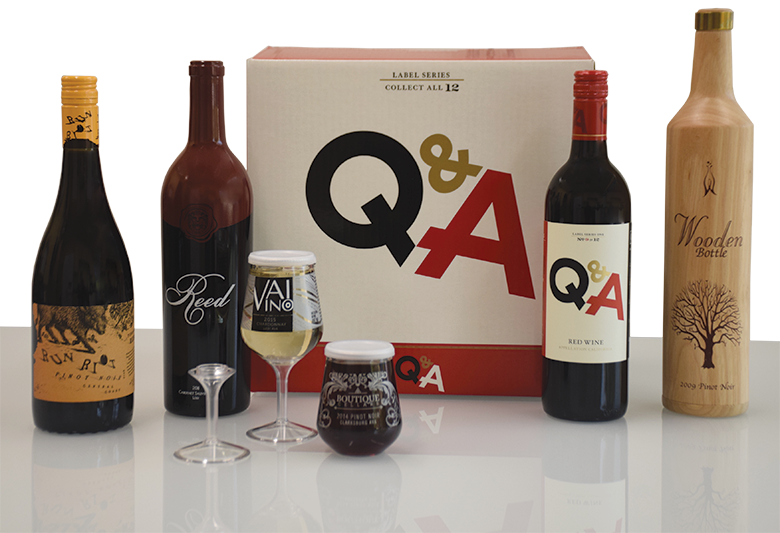 Wines & Vines Packaging Conference Design Awards winners
Wines & Vines Packaging Conference Design Awards winnersLittle-known California wineries are taking the lead with innovative packages that make them stand out. A judging panel (including this writer) for the Wines & Vines Packaging Design Awards evaluated and rated more than 120 entries from wineries and wine industry packaging suppliers. The panel chose its favorites in three categories, and the 50 top submissions were displayed at the Wines & Vines Packaging Conference on Aug. 17.
The judging panel, made up of five wine and design professionals, reviewed bottles and other formats submitted by wineries and industry suppliers such as packaging manufacturers and designers. Wines & Vines received 86 entries from wineries and 35 from suppliers. Among the supplier entries, the judges chose winners in the categories of Most Outstanding and Most Innovative. Among the winery entries they selected a winner for the the Most Outstanding category. Magazine editor Jim Gordon and graphic designer Rebecca Arnn handed out the five awards in a ceremony at the end of the conference.
People’s Choice winners
READ MORE »
Packaging
May 2016Alternatives to Glass Packaging
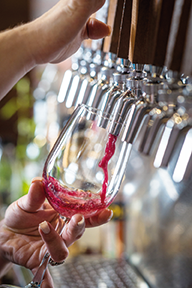
In 1991 the sale of table wines in non-glass containers was allowed in Italy, including polylaminate, PET (polyethylene terephthalate), bag-in-box (BiB) and aluminium cans. Since 2008, Protected Designation of Origin wines can also be packaged in BiB (used mainly when buying bulk wine), if permitted by production regulations. Additionally, steel kegs have been authorized by EEC regulation 822-07 for the sale of wine on tap. In this case the container can withstand pressure of up to 100 atmospheres.
In Italy, many everyday wines packaged in paper products, aluminium and polyethylene are well accepted by consumers. In France you can also find mid-range and Appellation of Origin Controlled wines sold in cartons. These containers are eco-friendly, light and recyclable; the square-cornered shape makes all the handling phases of the product easy, right up to when it is consumed. Volumes range from 200ml to 1 liter for different types of consumers. Cartons allow wine to be preserved even longer than 12 months (the legal expiration date), and the packaging is a good barrier against light and oxygen damage because of the small amount of head space (Baroni et al., 2013).
Other rapidly spreading forms of packaging such as PET bottles and BiB allow a much shorter shelf life for wine—typically between two and nine months.
Plastic packaging materials may release unwanted substances into wine and can also modify aromatic properties through “flavor scalping” (the absorption of volatile aroma compounds), depending on the characteristics of the materials and molecules involved (Lunardelli et al., 2009). Other factors may influence this phenomenon, such as the volume of packaging in contact with the wine, wine pH, SO2 level and storage temperature.
Another aspect to consider is the permeability of plastic materials, especially to oxygen, and consequent deterioration of the product. Wine producers should monitor the evolution of their products in contact with these materials in relation to expected storage times.
To reduce the environmental impact of packaging and transport, higher quality wines destined for aging can make use of lightweight glass bottles. The most suitable choice of packaging always depends on expected shelf life of the product and on the type of distribution and marketing planned.
Bag in box
READ MORE »
Packaging
May 2016Outstanding Wine Packages
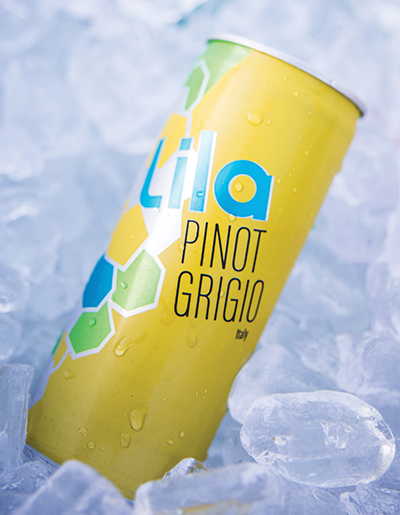 Domestic wine brand Ninety Plus Cellars is launching a line of canned, imported wines called Lila Wines to cater to millennials.
Domestic wine brand Ninety Plus Cellars is launching a line of canned, imported wines called Lila Wines to cater to millennials.The annual Unified Wine & Grape Symposium in Sacramento, Calif., provides an exhaustive exposition of industry suppliers from the vineyard through the tasting room. The Wines & Vines crew scours the tradeshow floor in search of new ideas to source a year’s worth of stories, returning with suitcases full of information and contacts.
Gold medal for Silver bottle
READ MORE »
Packaging
March 2016The Changing Landscape of Wine Bottles
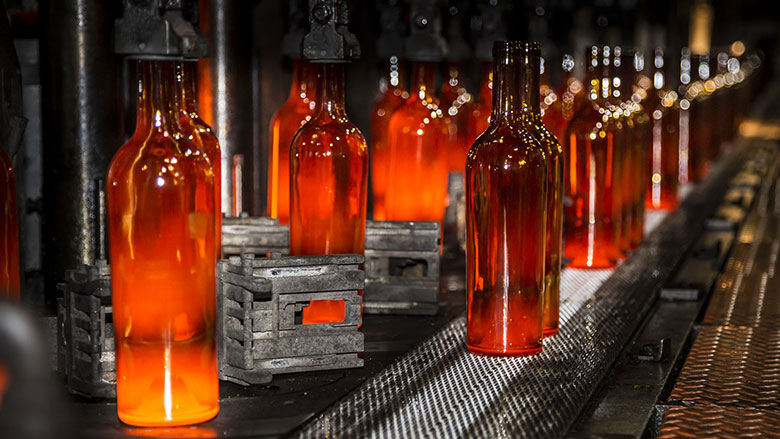 Gallo Glass has 14 machine lines and employs 690 full-time staffers in California's San Joaquin Valley.
Gallo Glass has 14 machine lines and employs 690 full-time staffers in California's San Joaquin Valley.Winemakers and packaging designers have confirmed that the wine industry remains conservative when it comes to adopting new presentations (see “Designer Dreamscapes” in the January 2016 issue). New bottle shapes and sizes are a hard sell—especially on retail shelves—for well-documented reasons.
Packaging suppliers, however, continue to introduce new options and find buyers willing to invest in small alterations to make their wine stand out and even raise its perceived value.
Glass bottles manufactured in the United States and Europe remain high-quality options, while complaints about quality and consistency from low-cost Asian imports continue, according to wine industry sources. Glass prices have remained relatively stable in the past year.
Glass acts
READ MORE »
Packaging
January 2016Designer Dreamscapes
 Including metal labels or embellishments are ways of conveying a sense of luxury to wine consumers.
Including metal labels or embellishments are ways of conveying a sense of luxury to wine consumers.Star packaging designers who addressed Wines & Vines’ second annual packaging conference in August 2015 seemed to agree: The North American wine industry tends to be extremely conservative about adopting novel packaging designs and solutions.
For a business that is inherently creative (a new vintage every year, farming and legal challenges, shifting market strategies), this might seem off-kilter. On the other hand, the New World’s belated embrace of wine as a mass-market beverage—and the practicalities of retail display and home storage—do, in some ways, mandate conservative decisions. Even if it might stand out, few dare try to sell a wine that won’t fit on shelves and wine racks. On-premise sales are often ignored in the design process.
Winemaker and restaurant consultant Pietro Buttita, who attended the Wines & Vines Packaging Conference, commented afterward: “It is often assumed that restaurant wines don’t need creative packaging, but the buyer still needs to have interest and the packaging can help anchor that decision-making process, especially in that meaty $10-15 wholesale per bottle zone.”
Buttita’s Rosa d’Oro brand produces some 2,000 cases annually in the Kelseyville Bench appellation of Lake County, Calif., giving him first-hand understanding of marketing boutique wines.
“Small producers are often not so great with general brand design and integrating website, packaging, print collateral, etc., in a meaningful way. With the plethora of brands out there, there really isn’t much reason to assume that anyone is unique, or that ‘small, family-owned’ means anything,” he said.
“Label design seems like a burden to many small producers, the last thing they want to think about. Or it is outsourced and clearly unconnected. I encourage small wineries to think of it the opposite way, as chefs think of their menus.
“The bottle is the primary document, and though dialing it in is a long process I feel that grower/producers (whom I prefer to work with) need to think of it as the executive summary of their business plan—that icing on the cake. Especially when you only have a few hundred cases, keep it meaningful and personal. So many bottles out there lack integrity, like a menu that doesn’t deliver or transparently convey the experience to come. Even small labels spend a lot of time guessing what the consumer wants, rather than focusing on the nature of their product,” he said.
For Rosa d’Oro, Buttita worked with Kerri Green Design of Oakland, Calif., to draw heavily on Old World southern Italian packaging for the style. This, Buttita said, “Gives it a sense of location in time and place using screen-print bottles that work with our limited bottling space. The wine was not made in an international style, so hopefully the packaging reflects the style markers to some extent,” he said.
“This might be the exception when brands reach for either modern labels or classic. Nothing is more disappointing than super-neat packaging and boring, oak-chipped, sweet ‘anywhere-wine.’”
Design inspiration
READ MORE »
Packaging
November 2015Little Things Mean A Lot
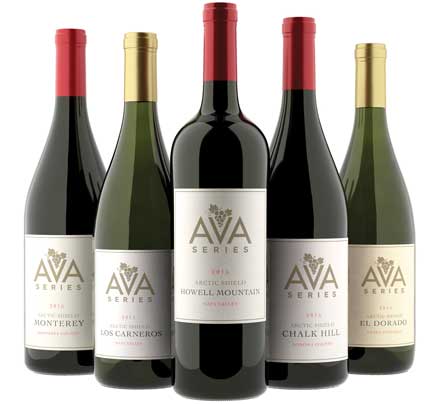 The AVA Series label by Labeltronix demonstrates the new capabilities of label stock.
The AVA Series label by Labeltronix demonstrates the new capabilities of label stock.Improving the performance of your wine package may not require a complete redesign. Sometimes small changes can make a big difference in wine sales and profit margins. From the label stock to the closure to bottling—and then later in the tasting room—a slightly different approach can make a major impact.
As we do every fall, Wines & Vines scoured dozens of submissions to the packaging section of our November supplier listings, looking for new products and services we haven’t previously covered. If something strikes your fancy, find contact information in the Buyer's Guide Online.
If you’re looking for inspiration, start right here to learn about some possibly unexpected sources.
Get it on paper
READ MORE »
Packaging
October 2015Building Value with Wine Packaging
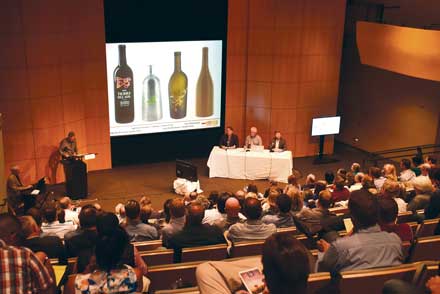 Andrew Rice, creative director of Trinchero Family Estates (at podium), moderates a panel of designers including Tony Auston, Jim Moon and Jeff Hester.
Andrew Rice, creative director of Trinchero Family Estates (at podium), moderates a panel of designers including Tony Auston, Jim Moon and Jeff Hester.After sealing the deal to sell his Meiomi brand to Constellation Wines for $315 million, Joe Wagner became the wine industry’s newest “it boy.” The fifth-generation Napa Valley winemaker opened the second annual Wines & Vines Packaging Conference in Napa on Aug. 19, giving the keynote address.
The 33-year-old Wagner described his family’s single-vineyard Pinot Noir label Belle Glos as the leading luxury Pinot Noir in the United States, thanks in part to a distinctive, instantly recognizable package. Wagner recounted the evolution of the Belle Glos package for conference attendees. What started as a simple, red wax seal has grown to envelop the top half of Belle Glos’ bottle in scarlet wax. “I think we are the largest consumer of wax in the wine industry,” he told the audience.
Applying wax dips is normally an arduous task performed by hand, but Wagner commissioned an Italian manufacturer to develop an automated system with the goals of safety and consistency. He passed around samples of a proprietary tear tab, which simplifies removing the cork without disrupting the visual flow of wax.
Along with the “Sideways” effect that helped propel Pinot Noir sales starting in 2004, he believes the package helped build recognition of the Belle Glos brand. The package now has a trade-dress trademark on its wax dipping, and a patent is pending, Wagner said. “People are always trying to steal a good idea.”
Wagner started his own company in 2014, Copper Cane Wine & Provisions, and remains involved in The Wagner Family of Wine as well. He enumerated what he looks for in a wine package:
Exclusivity: Make it something special. Belle Glos bottles are not quite the traditional Burgundy shape.
Individuality: Make the package one of a kind.
Tradition: Wine buyers are accustomed to standard shapes. Get too far off the standard, and people lose interest.
Tell a story: Package for your purpose. Are you selling on- or off-premise? This can make a big difference in sales.
READ MORE »Packaging
May 2015Continual Improvement at Packaging Facility
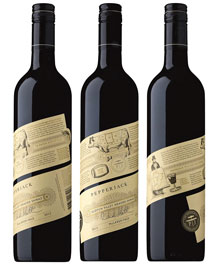 Pepperjack's wraparound label differentiates the Graded Collection.
Pepperjack's wraparound label differentiates the Graded Collection.The boss of one of the world’s most advanced wine bottling facilities says there’s nothing better than success based on teamwork. Danni Casey, site operations manager for the Wolf Blass Packaging Centre, says her competitive nature helps drive her to look at every process and work out how to improve it.
The state-of-the-art packaging facility, surrounded by vineyard in the Barossa Valley of South Australia, was built in 2005 at a cost of about $120 million (all figures in Australian dollars), employs about 200 people, has multiple bottling lines capable of filling 24,000 bottles per hour, labeling lines capable of 26,000 bottles per hour and a 22,000-pallet storage facility operated by nine robotic cranes.
“We are very, very lucky to have all this technology, and it has all been put together so well,” Casey said. But despite the giant scale of the operation, the staff’s focus on “continuing improvement” means even the smallest operations are scrutinized. A change to the way the facility carries out torque tests of screwcaps is just one example. The test actually destroys the cap, which means both bottle and cap are destined to be recycled. The test used to be conducted on bottles that already had been filled and sealed, until someone realized they were wasting 16 full bottles of wine every two hours. Now the tests are carried out on empty bottles, and thousands of liters of wine are saved each year.
“We have consistently driven our costs per case down,” Casey said. “When I first started here as a line manager in 2008, the average change-over time on a line from one product to another was 90 minutes. It’s now 35 minutes.
“The whole business has changed as well. We are now bottling wine to order, rather than filling up whole sheds of certain products. We do a lot smaller runs and have more SKUs (stock keeping units).”
Challenging new labels
READ MORE »Packaging
March 2015Think Ink
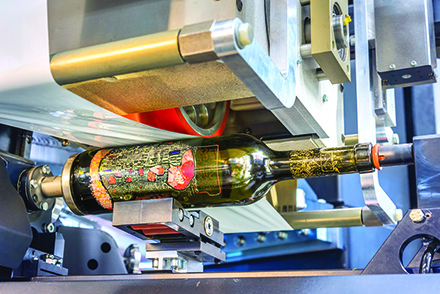 MB Corp.'s custom-built screenprint equipment can produce elaborately decorated bottles like this while conserving energy and the atmosphere.
MB Corp.'s custom-built screenprint equipment can produce elaborately decorated bottles like this while conserving energy and the atmosphere.During the first years of the 21st century, the wine industry bought into the “green” concept of sustainability in a big way. With programs ranging from rigid self-assessment to organic certification to Biodynamic growing, vintners now serve their consumers a menu of guilt-free options that protect the environment, the economy and social equity.
The ever-changing array of wine packaging continues to keep pace, although the “sustainability” of various options remains a subject of debate. Which is greener: natural cork, synthetic stoppers or screwcaps? Which is more earth-friendly: glass bottles, bag-in-box or kegs? Winemakers and suppliers each have their own take, and their decisions contribute to the wealth of choices on retail shelves and delivered to the homes of wine club members.
One thing everyone agrees on, though: Branding your wine is key to sales. One way or another, this means printing—whether on boxes, labels, capsules or directly on the bottle.
Enter the ink, which was “invented” and first put to use by the Chinese around 256 BC. Wines & Vines has been writing about organic ink for at least five years, when proudly green wineries began adopting it for labels and shippers. Interest and choices in organic ink continue to grow.
Light ’em up
READ MORE »Packaging
January 2015Make the Most of Shipping Cases
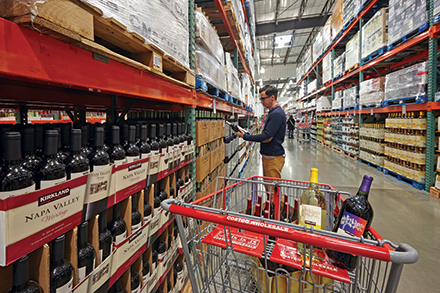 France Freeman—Courtesy Costco
France Freeman—Courtesy CostcoIt’s generally acknowledged that retail consumers make snap judgments when faced with shelves of wine. While varietal, origin and price are the first elements consumers evaluate, it’s the package—bottle size, shape, color and label or décor—that seals the deal. What’s in the bottle is key to future purchases, but that first impression may persuade consumers to take the plunge and make the first buy.
Luring shoppers to a display and making eye/hand contact with the first bottle includes one packaging element that’s often overlooked: the shipper/carton. The appearance of a shipper can compel merchandisers to feature wines on endcaps (at the ends of retail store aisles) and attract additional interest and sales, according to leading wine retailers.
A simple brown corrugated case shipper may serve the basic function of safely transporting bottles to the retail floor, but more elaborate decoration can further your brand message.
Curtis Mann is the senior business manager for wine, beer and spirits at Raley’s Family of Fine Stores. Headquartered in Sacramento, Calif., Raley’s has 120 supermarkets in Northern California and Nevada. Mann emphasized the importance of shippers for retail displays during his presentation at the Wines & Vines Packaging Conference in August.
Although he’s not seen a tidal wave of new shipper design, “People have gone beyond just cardboard,” he told Wines & Vines during a recent interview. In grocery retail, “The label sells. Shippers can influence what is or is not displayed” at individual stores, depending on local demographics.
Wineries would be wise to take a lesson from the rapidly growing craft beer industry, Mann said. “Look at beer. People buy beer in 12-packs. Brewers like Lagunitas Brewing Co. display variety packs in different forms, building an in-store billboard. It’s good to get that billboard display. Vintage dates are not required on a wine box,” he said.
“What we see are items on display get a 24% increase (in sales) vs. those featured in our print ads,” Mann noted. “When people come in, they are looking by varietal. They generally are not too brand loyal, and they are willing to switch” if drawn to an in-store display.
Individual store merchandisers implement display levels. “At the store level, case shippers are important,” he said. “Stores like to build displays, and they are probably more interested by the box.”
Mann said that box manufacturing and printing has improved along with attention to the shippers. “There are only so many opportunities to promote your product. Your best opportunity is to take advantage of what you can.”
Packaging may not be the reason consumers buy your product, but he stressed, “It’s an important component that you can continue to activate after sales via clear, concise messaging.”
Expensive wooden presentation boxes are never discarded at Raley’s, and they may be re-used after their initial display, Mann said. Corrugated case shippers may be recycled at checkout. He recommended using 12-bottle case shippers vs. lay-down six-packs, which are difficult to position at retail.
“Think about selling for retail: Stacking flat six-packs is difficult. To sell a lot of cases, they have to be easily stackable,” he said.
Cues from Costco
READ MORE »Packaging
November 2014From Branding to Bottling
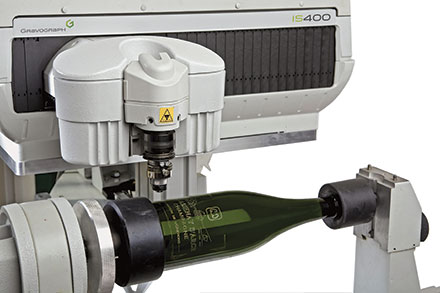 Gravotech's Gravograph M40DeepVice is suitable for engraving personalized wine bottles.
Gravotech's Gravograph M40DeepVice is suitable for engraving personalized wine bottles.Our November issue focuses on the new products and services reported by hundreds of suppliers to the North American wine industry. Wine packaging is among the most progressive segments in terms of innovation; more than 100 suppliers chose to be featured in the packaging section of our listings.
From this compilation of valuable information, we cherry-picked a dozen packaging suppliers with attention-grabbing responses. Take a look at what they are offering, and then check out what else is available within the comprehensive listings starting on page 35.
Brand development and package design
READ MORE »Packaging
October 2014Choosing a Fraud-Prevention System
Editor’s note: The first installment of this two-part series about the problem of counterfeiting in the international wine trade (see “Protecting Your Wine” in the August 2014 issue of Wines & Vines) described the extent of wine fraud and introduced the types of anti-counterfeiting technologies potentially useful in the wine business. This second installment more closely examines track-and-trace tactics in search of the best anti-counterfeiting solution.
NFC chips for wine are often placed along the capsule edge or behind the label. Photo: SelinkoThere are generally three types of counterfeiters: direct manufacturers, suppliers of empty bottles or illicit alcohol, and intermediaries within bars and clubs. It is difficult for wine producers to keep up with the variety of forged wines that are illicit, mobile and not sufficiently pursued by the local authorities. Bordeaux’s Cha?teau Latour confirms, “The remote authentication of Grand Cru wines with wine merchants is virtually impossible.”
Under these circumstances, anti-counterfeiting technologies—particularly those intended to minimize the “Chinese risk”—have assumed a clear and incontrovertible strategic importance for producers of high-end wines and spirits. We can also see that, in the Chinese market, traceability methods are not always imposed on the importer, and the importers themselves are not always adequately monitored. Therefore, protecting the bottles upstream appears to be essential.
“The real solution is to ensure that the bottles leaving Bordeaux are difficult to copy and easy to identify,” Jean Guillaume Prats, chairman of Chateau Cos d’Estournel, states in an article in Le Nouvel Economiste.
The growing importance of RFID
READ MORE »Packaging
October 2014Tasting the Effects of Wine Closures
The wines with natural corks (left) show a bigger disparity in color than synthetic closures (middle) or screwcaps (right) because of cork's wider range of oxygen transmission (OTR). The darker 'high slope' wines had the highest rate of color absorption over time, meaning a greater OTR. Photo: UC DAVISThe recent Wines & Vines Packaging Conference featured two tastings that showed how closure choice can affect wine quality.
The first tasting, sponsored by Guala Closures, took place in the morning and featured wines by CADE Winery in Napa Valley. CADE is part of the PlumpJack Group, and John Conover, general manager of PumpJack Winery and partner in CADE, said the company had been open to alternative closures because the founding partners saw first-hand how unpleasant a corked wine was for customers of the original PlumpJack Wine & Spirits shop in San Francisco, Calif. He said that experience helped motivate the company’s willingness to bottle its estate wines under screwcap as well as participate in a study on closures with the University of California, Davis.
Both sessions, held in the demonstration kitchen of the former Copia building in Napa, Calif., drew a full crowd of 75 people. The tastings were conducted with Rastal glassware from Germany, provided by conference sponsor Chrislan Ceramics.
Dr. Anita Oberholster, cooperative extension specialist in enology for UC Davis, provided an overview of the research project that is being headed up by Dr. Andrew Waterhouse, as well as some early conclusions. “The first question the research is attempting to answer is whether variability using a specific closure is large enough that a consumer can taste the difference,” Oberholster said.
Collaborative closure study
READ MORE »Packaging
October 2014Case Study on Applying Packaging Innovations
 Calista's 360-degree design involves four separate panels that wrap around the entire bottle.
Calista's 360-degree design involves four separate panels that wrap around the entire bottle.As executive vice president of marketing for Purple Wine Co. and Sonoma Wine Co., Lisa Ehrlich has been at the helm of a three-year packaging transformation for Purple Wine Co.’s brands. She discussed the process while speaking at the Wines & Vines Packaging Conference in August.
Purple Wine Co. is the branded wine arm of the company, while sister Sonoma Wine Co. is a winery services operation from crush to bottling that produces Purple Wines as well as those for other wine companies.
Sonoma Wine Co. processes 4 million cases of wine per year, of which 25% is the company’s own brands.
Purple was best known for its 600,000-case Mark West Pinot Noir brand, which it sold in 2012 to Constellation Brands, triggering the redesign and new focus on its other brands. All products but one have changed in the past two years: Four packages have been redesigned, four new brands were introduced, and one stayed the same.
Ehrlich noted that change is not always good. “You don’t want to just change for the sake of change. You don’t want to lose existing consumers and accounts loyal to a brand.”
But there can be good reasons to change since the market is competitive, she said. There are more brands and labels every day, and innovation may make sense to stand out from the pack.
Wineries can use packaging to tell a story about the wine, explain where it comes from and give it a sense of place and identity.
Elements in packaging can also suggest luxury, elevating the value of the wine among potential buyers, Ehrlich observed. And the right package can help set expectations about how the wine will taste.
Unusual packages can create buzz, providing something new to talk about with distributors and key accounts, as well as a reason to visit them or present new information. But more than that, she said, exciting packaging will generate interest among consumers and the press.
The best packaging does all the above.
READ MORE »Packaging
March 2014Winery Glass-Buying Patterns Evolve
 Innovative bottle shapes are growing in popularity. Global Package distributes the MBS self-decanting bottle (left), while Bruni offers the 750ml Duo Fondos bottle (right).
Innovative bottle shapes are growing in popularity. Global Package distributes the MBS self-decanting bottle (left), while Bruni offers the 750ml Duo Fondos bottle (right).As the economy hobbles back to a normal stride, wine consumption and brands continue to grow, but nothing is as certain as uncertainty in the wine industry.
Despite growing competition from alternative packaging in ever-new guises—bag-in-box, pouches, boxes, single-serve PET ready-to-drink vessels and more—glass bottles remain the industry standard.
We contacted leading suppliers of glass wine bottles, who shared their observations, opinions and predictions about their industry. Our respondents include: Marty Sychowski,?president of?All American Containers, Pacific Coast; Jean-Pierre Giovanni, VP sales and marketing, West Coast, at Bruni Glass; Erica Harrop, president of Global Package LLC; David Schwandt, VP sales, wine category, at Saxco International; Suzanne Gordon, sales manager for TricorBraun WinePak; Bob Parise, vice president, sales, at Verallia North America, and Cynthia Fisher, sales manager at West Coast Bottles.
Bottle buying patterns
READ MORE »Packaging
January 2014Bleeding-Edge Packaging Tests the Market
There’s no shortage of drama at Truett Hurst Winery. The six-year-old company went public this summer; one director (entrepreneur William Hambrecht) stepped down, and net sales increased by about 5%, according to its first-quarter financial statement issued June 26, 2013. On top of this, the Healdsburg, Calif.-based winery has launched three radically different packages since October 2012.
READ MORE »Packaging
November 2013New Wrinkles in Wine Packaging
Our annual November survey offers hundreds of suppliers an opportunity to post news about their companies’ freshest products for the grape and wine industry. It also offers us a peek at developments we’ve not previously published.READ MORE »Packaging
October 2013Message on a Bottle
With a growing number of wine brands crowding the shelves, small wineries can find it challenging to make their products stand out.
READ MORE »Packaging
May 2013Over-Labeling Simplified
In a world where wine packaging options are limitless and still growing, the term “over-labeling” might provoke bemusement. When you can envelop a bottle in flashy shrink wrap, embellish it 360° with etching or screen print or apply die-cut embossed, foil-stamped labels on front, back and neck, excessive labeling doesn’t seem possible.READ MORE »Packaging
May 2013'Boxing' with Don Sebastiani & Sons
Three years ago, Don Sebastiani & Sons of Sonoma, Calif., embarked on a 3-liter bag-in-box (BIB) project for Pepperwood Grove. With the ongoing success of this brand in standard 750ml bottles and demonstrated consumer interest in premium boxed wine, we dove into this segment with our Pepperwood Big Green Box.READ MORE »Packaging
March 2013Bottle Makers' Outlook Is Rosy
Alternative wine packaging has made nary a crack in glass bottles’ domination of the wine industry. Bag-in-box, PET, pouches and aluminum options appear to have swallowed some of the extra volume of increased wine production and consumption worldwide, but glassmakers maintain their traditional grasp on most wines at every price point.READ MORE »Packaging
November 2012Perk Up Your Packaging
Every year for our November issue, Wines & Vines asks wine industry suppliers to send brief updates about their newest products and services, which we organize by category (see page 55.) This year, we pored through dozens of early submissions in search of fresh ideas to help readers considering changes to their wine packaging. Whether you’re contemplating a complete redesign or hoping to improve your existing operation, we hope these innovations will feed your creative instincts.READ MORE »Packaging
October 2012More Than A Label
After years of labor in the vineyard and months in the winery, producers of handmade, artisan wines might be tempted to put their vintages in simple bottles with classic labels and closures and call it a day. In an ever more competitive marketplace, however, this could be the most shortsighted decision to make for a long-term business.READ MORE »Packaging
May 2012Flasq of Inspiration
Shiny aluminum tubes are luring youthful buyers to a trio of wines blended in Napa Valley. As sleek and slender as the health-conscious patrons of the Whole Foods stores that stock them in 33 states, the wines and their containers were designed specifically to attract members of the millennial generation (ages 21-34) seeking healthful alternatives and green products.READ MORE »Packaging
May 2012Study Examines Bottle Variation
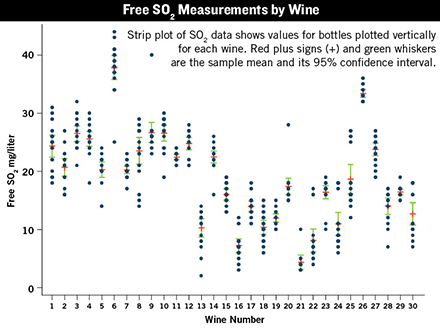 Source: DIAMBack in November 2009, 14 wine industry leaders from a range of disciplines met to discuss a major study on what should be an important topic for the wine trade: bottle variation. It could rightly be called the dirty secret of the industry.READ MORE »
Source: DIAMBack in November 2009, 14 wine industry leaders from a range of disciplines met to discuss a major study on what should be an important topic for the wine trade: bottle variation. It could rightly be called the dirty secret of the industry.READ MORE »Packaging
March 2012High-End Retailers Talk Packaging
Monday, Jan. 2, was a federal holiday, but The Back Room in downtown Napa, Calif., was open for business. When a pair of young women came in search of a special bottle to share that chilly afternoon, they had a rough idea of what they might like, but asked merchant Chris Foster for guidance. Familiar with the diminutive shop’s ever-changing selection of small-production wines, Foster helped them zero in on some hard-to-find French red wines, which they discussed in detail.READ MORE »Packaging
January 2012Test Your Bottling Device IQ
Of all the necessary tasks required to bring wine from vineyard to shelf, bottling is probably the one most often farmed out to specialists: the mobile bottlers. In an increasingly competitive market, mobile bottlers are motivated to maintain their rigs to the highest standards, offer a multitude of packaging capabilities and protect their clients’ wines from oxidation during bottling.READ MORE »Packaging
October 2011See Your Brand On the Big Screen
Smaller brands seeking major shelf impact might consider a switch to screen-printed bottles. “A winery that currently is producing 1,500 to 3,000 cases of a one- to three-SKU tier” with languishing sales would be an ideal candidate to make the switch, according to Michael Bergin, owner of Bergin Glass Impressions of Napa, Calif. Rather than redesign a paper label, he suggested this could be the perfect opportunity to refresh the winery’s look and create something very different to pop on the shelf.READ MORE »Packaging
October 2011New Class for L'Ecole No. 41
When Walla Walla’s L’Ecole No. 41 launched a new look and label last spring, it came as something of a shock to fans and industry observers. After all, the winery is one of Washington’s oldest and had been on a steady growth curve since it was founded in 1983. (This year it is expected to produce some 35,000 cases.) Its label, a colorful, “folk art” depiction of the namesake one-room schoolhouse—still a landmark beside a rural highway—was both charming and highly recognizable.
READ MORE »Packaging
October 2011A New Façade for Boxed Wines
It’s official: Boxed wines are now mainstream. In August, the consumer wine press conceded the issue: Grant Butler wrote in the Portland Oregonian, “What’s going into those boxes has improved dramatically.…More restaurants are turning to boxed wine for by-the- glass pours.” In The New York Times, Eric Asimov led his blog, “The Pour,” saying: “It’s the epitome of déclassé, the vinous equivalent of trailer trash, the wine snob’s worst nightmare.”READ MORE »Packaging
May 2011Packaging Product News
The packaging industry in 2011 is on a sustainability mission. As the wine industry continues to adopt environmentally friendly practices, the pressure to go green has forced suppliers to create products that are lighter, smaller, more cost-effective and ultimately reduce the carbon footprint. Here are 10 new packaging items that are both useful to wineries and help make the world a greener and cleaner place.
READ MORE »Packaging
March 2011Looking Again at Glass
Wine packaging has taken giant strides during the past decade, providing more options for containers and closure. Many wineries now insist on eco-friendly containers, and many suppliers have stepped up to satisfy their needs with bag-in-box, TetraPak, Astrapouches, plastic and aluminum bottles, flasks and single-serves. But the overwhelming majority of wine in North America is still sold in glass bottles—and not just because that’s the traditional package.READ MORE »Packaging
January 2011Direct Shipping Cartons Evolve
Most vintners start their search for sustainability in the vineyard, husbanding water and eschewing chemical applications. Progress advances in the winery, with improvements to processes, green construction, reduction of power usage or conversion to solar. Changes in packaging tend to emerge later: alternative glues and inks, lighter bottles or no bottles at all. Now that direct-to-consumer sales have become an integral profit center, winemakers are turning their attention to the lowly wine shipper.
READ MORE »Packaging
October 2010Packaging for Handcrafted Wines
Packaging is an essential marketing element for wineries of every size, but extremely small wineries face additional challenges. For this first annual Artisan Winemaking Issue, we contacted some of the smallest producers across the United States to learn what packages they chose and why.
READ MORE »Packaging
August 2010Glass Closures Break Through
Transparency is what wineries should be focusing on these days, if the conventional wisdom of the Twitteratti and other social media and marketing types carries any weight.READ MORE »Packaging
May 2010Eight Sides of Wine
In early March, the wine press got a preview of Underdog Wine Merchants’ next major initiative: Octavin, the home wine bar. To unveil the new package, Adam Richardson, the company’s director of winemaking, hosted a tasting at a penthouse apartment on Madison Avenue in New York City, where the five brands currently available in the new octagon-shaped package were on display inside the fridge and on a marble countertop.
READ MORE »Packaging
May 2010Investing in Good Labels
Printers and labeling equipment makers are looking to brighter times in 2010, after a grim 2009. Sales already are topping last year’s figures for some companies, while much of the growth in printing volumes are attributable to the emergence of new, lower priced wine brands as wineries recalibrate their product lineups.
READ MORE »Packaging
January 2010Save Costs and Shelf Appeal
Sweating the small stuff can make a big difference for wineries looking to save money while still looking sharp on retail shelves.
READ MORE »Packaging
November 2009Pushing the Packaging Envelope
Attuned to a healthy appetite among wine consumers and sellers alike for popularly priced wine that is more environmentally friendly, wineries and the packaging manufacturers who supply them are continuing to push the envelope on alternative formats. As a result, they are realizing significant gains in consumer acceptance, recyclability and reductions in greenhouse gas emissions.
READ MORE »Packaging
May 2009Label Makeovers
Many years ago, when I was working for an importer of Italian wines, we lost our top-selling Chianti brand to a competing importer and marketer. Suddenly we found ourselves in the midst of a mad scramble to replace tens of thousands of cases worth of business overnight.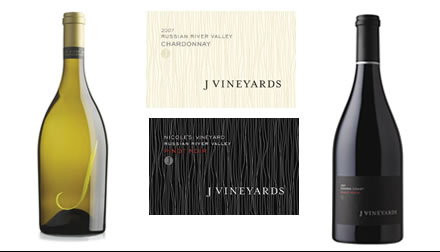 J Vineyards is straying from its well-recognized silkscreened design (left) to draw attention to its site-specific Chardonnay and Pinot Noir (right).READ MORE »
J Vineyards is straying from its well-recognized silkscreened design (left) to draw attention to its site-specific Chardonnay and Pinot Noir (right).READ MORE »Packaging
May 2009Innovations in Packaging
Recession, global warming and a new consumer willingness to experiment seem to be conspiring to make wine packages more varied, less expensive, lighter weight and higher tech than ever before. In this regard, wine packaging lags behind packaging for other beverage and food industries. Plastic twist-caps, synthetic labels and drink pouches, for instance, already are familiar to consumers of mineral water, soda and apple juice, but now they're coming to a winery near you. These and a sampling of other packaging innovations are introduced here in snapshot format.
READ MORE »Packaging
May 2009The Label Option Maze
Singers from Bo Diddley to Stevie Wonder to Tim Hardin have drummed in the same piece of sage advice: Don't judge a book by its cover. There was even an episode of "Desperate Housewives" with that title. Meantime, wine consumers continue to judge--and purchase--wines by their labels. Where's Stevie when we need him?
READ MORE »Packaging
January 2009Life Under Screwcap
When bottling under screwcap started to make a splash a decade ago, the promise was that the wine in your glass would be exactly the wine that left the cellar in a bottle--no chance of cork taint (since there was no cork), no wine leaking out, no oxygen leaking in, just the finest product of the winemaker's art, perfectly preserved. After all the misery inflicted on generations of winemakers and wine drinkers by moldy corks, the screwcap vision sounded too good to be true.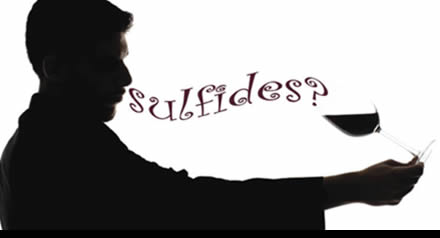 Although screwcaps don't put wine at risk for cork taint, they cut off the supply of oxygen to bottled wine, which can bring unpleasant sulfide aromas to the surface.READ MORE »
Although screwcaps don't put wine at risk for cork taint, they cut off the supply of oxygen to bottled wine, which can bring unpleasant sulfide aromas to the surface.READ MORE »Packaging
January 2009The Hunt for TCA
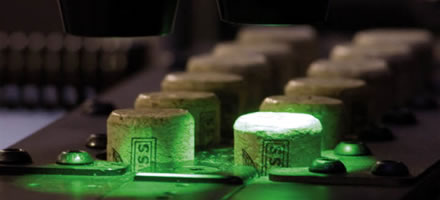 In recent years, natural cork manufacturers have relied heavily on quality control (seen above at ProCork) in order to eliminate the risk of TCA.
In recent years, natural cork manufacturers have relied heavily on quality control (seen above at ProCork) in order to eliminate the risk of TCA.Cork manufacturers' struggles with taint are well documented. The major compound responsible for musty taints associated with cork -- 2,4,6 - Trichloroanisole -- is formed in cork bark by the chemical combination of phenolic compounds and chlorine. The phenolic compounds are present as a result of the breakdown of lignin, which is the hard substance that naturally occurs in tree bark. The chlorine can come either from the environment or from fungi living on or in the bark.
READ MORE »Packaging
May 2008Label Design Suppliers
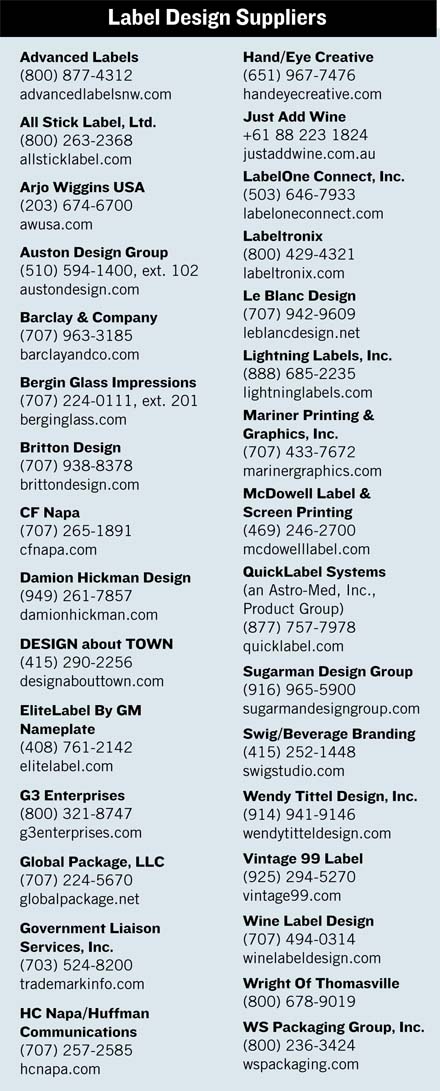 READ MORE »
READ MORE »Packaging
May 2008Diversification or Diversion?
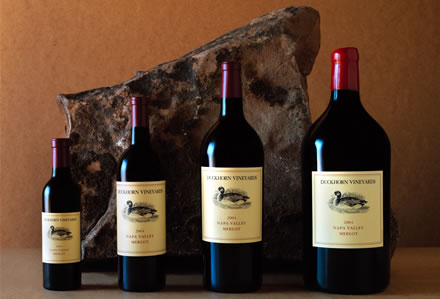 Bill Nancarrow, executive winemaker for the Duckhorn Wine Company, says it takes about an hour to modify Duckhorn's bottling process to accommodate different size bottles. The sizes above, from left to right, represent 375ml, 750ml, 1.5L and 3L bottles of the winery's Merlot.Are half bottles and magnums worth the trouble? The main delivery system for premium wines is, was and will continue for the foreseeable future to be 750ml bottles. But smaller and bigger sizes have their own attractions, marketplaces and uses--especially restaurant sales for half bottles, and collectors for magnums and even larger sizes.READ MORE »
Bill Nancarrow, executive winemaker for the Duckhorn Wine Company, says it takes about an hour to modify Duckhorn's bottling process to accommodate different size bottles. The sizes above, from left to right, represent 375ml, 750ml, 1.5L and 3L bottles of the winery's Merlot.Are half bottles and magnums worth the trouble? The main delivery system for premium wines is, was and will continue for the foreseeable future to be 750ml bottles. But smaller and bigger sizes have their own attractions, marketplaces and uses--especially restaurant sales for half bottles, and collectors for magnums and even larger sizes.READ MORE »Packaging
May 2008Bottle Suppliers
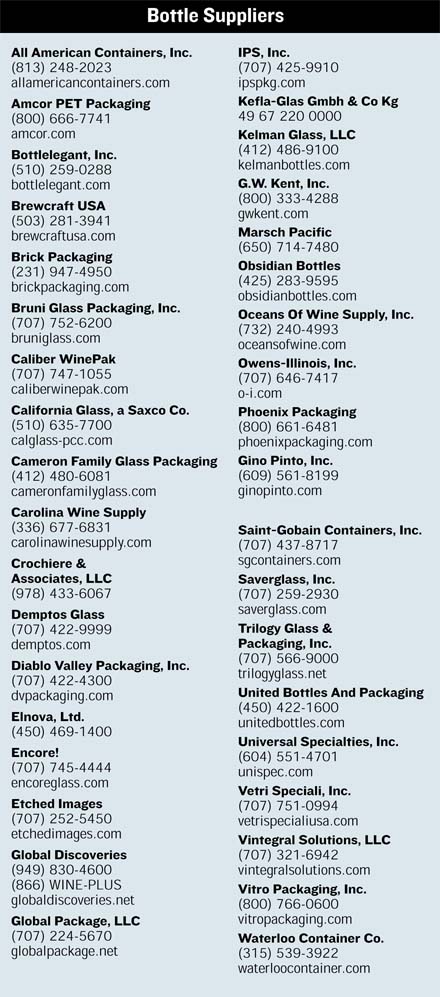 READ MORE »
READ MORE »Packaging
May 2008In-House or Outsource?
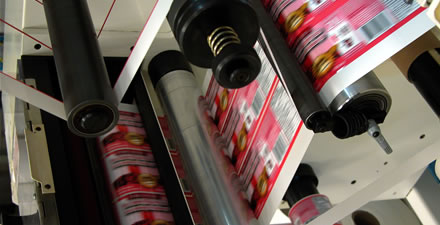 Maritime Labels & Packaging of Bedford, Nova Scotia, which uses HP Indigo digital presses, is popular with area wineries looking to improve the quality of their labels. Maritime uses a custom formulated priming solution that enables its digital presses to print on a wide variety of materials.Working as a winemaker with some of the biggest names in the British Columbia wine industry--as well as overseas--gave Bruce Ewert a firm grounding in the principles of operating a winery. Now, he's applying two decades of experience as he prepares to open the first organic winery in Nova Scotia, on Canada's Atlantic coast.READ MORE »
Maritime Labels & Packaging of Bedford, Nova Scotia, which uses HP Indigo digital presses, is popular with area wineries looking to improve the quality of their labels. Maritime uses a custom formulated priming solution that enables its digital presses to print on a wide variety of materials.Working as a winemaker with some of the biggest names in the British Columbia wine industry--as well as overseas--gave Bruce Ewert a firm grounding in the principles of operating a winery. Now, he's applying two decades of experience as he prepares to open the first organic winery in Nova Scotia, on Canada's Atlantic coast.READ MORE »Packaging
May 2008Northwest Winery Goes Plastic
Being environmentally friendly also stands to improve distribution for one Northwest winery. Artisan Wine Co., a sister company to Mission Hill Family Estate winery of Westbank, British Columbia, is releasing two of its Painted Turtle wines--a Semillon-Chardonnay blend and a Cabernet-Shiraz blend (above)--in 750ml PET, or polyethylene terephthalate, bottles in Ontario this spring.READ MORE »CURRENT COLUMN ARTICLES »
